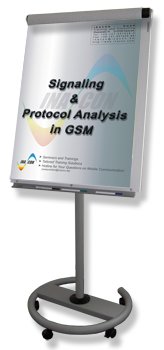 GSM - Signaling & Protocol Analysis
GSM - Signaling & Protocol Analysis
(The Core Network)
[2-day course, Euro 2,350.- (net) per participant]
 The GSM-Network and its Features
The GSM-Network and its Features

- The GSM-Network Architecture
Tasks and functions of BSS, MSC, IWF, VLR, HLR, EIR, SMS-SC, Voicemail. - Features of GSM
Functional Description of national and international roaming, Mobile Originating Call (MOC), Mobile Terminating Call (MTC), Interworking with data networks, Short Message transfer in mobile originating and mobile terminating direction (SMS), Supplementary Service features and Supplementary Service (SS) handling. - The Future of GSM
Introducing GPRS, EGPRS and UMTS - Practical and Interactive Exercises
 The SS7-Protocol Stack: MTP 1 – 3, ISUP and the SCCP
The SS7-Protocol Stack: MTP 1 – 3, ISUP and the SCCP
- The SS7-Network
Tasks, functions and differences between SP’s, SCP’s and STP’s, the IN-concept. - The SS7-Protocol Stack
Introduction and differentiation of MTP 1 – 3, ISUP, TUP, SCCP, TCAP, MAP - The Message Transfer Part (MTP 1 – 3)
Functional description and procedures, FISU, LSSU, MSU, Routing Label. - SS7 Network Management and Network Test
Functional description and procedures, message format and message types - The ISDN User Part
Functional description and procedures, message format and message types, important parameters for call setup and release - The Signaling Connection Control Part (SCCP)
Functional description, the SCCP-subsystems, message format and message types, connection-less and connection-oriented services, SCCP-parameter description. - Practical and Interactive Exercises
- Error Analysis of Real Life Recording Files for MTP 3, ISUP and SCCP
 The SS7-Protocol Stack: TCAP & MAP
The SS7-Protocol Stack: TCAP & MAP
- Transaction Capabilities Application Part (TCAP)
Functional description, parameter encoding and classes (primitives vs. constructors), strutcured dialog vs unstructured dialog, introduction to ASN.1 encoding, message format and message types, dialog portion, component portion, adressing principles of TCAP. - Mobile Application Part (MAP)
Functional description, common and special MAP-services (MAP-DELIMITER, MAP-OPEN, MAP-CLOSE, MAP-U-ABORT, MAP-P-ABORT, MAP-NOTICE), local operation codes for GSM, interaction between application, MAP and TCAP. - Practical and Interactive Exercises
- Analysis of Real Life Recording Files for TCAP and MAP
 Camel
Camel
- CAMEL Basics
Phase 1, Phase 2, Phase 3 functional description, features and architecture (gsmSSF, gsmSRF, gsmSCF) - CAP (Camel Application Part)
Procedures for Mobile Originating and Mobile Terminating Calls, procedures for SMS, procedures for pre-paid services. - Practical and Interactive Exercises
- Analysis of Real Life Recording Files for CAMEL
 Signaling Procedures & Functions
Signaling Procedures & Functions
- Registration and Location Updating
(Intra-PLMN and Inter-PLMN with CAMEL-Interworking) - Mobile Originating Call Setup
(Intra-PLMN and Inter-PLMN with CAMEL-Interworking for pre-paid services) - Mobile Terminating Call Setup
(Intra-PLMN and Inter-PLMN with CAMEL-Interworking) - Inter-MSC Handover and Subsequent Handover Function
- Short Message Transfer
(subscriber reachable and non-reachable) - Supplementary Services Handling
(Activation, Registration and Interrogation) - Practical and Interactive Exercises
- Analysis of Real Life Recording Files for the different scenarios
ℹ️ Try out the updated search below!
Search:
More Info:
General Information about this course
Schedule of this training course
Extract of this training course
INACON eBooks
Please have a look at our full offer

